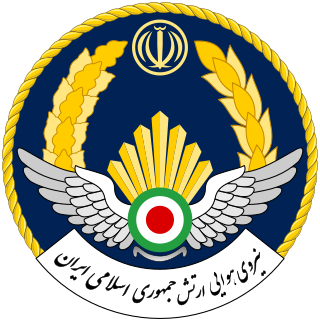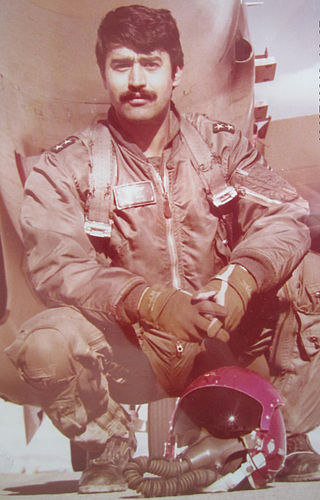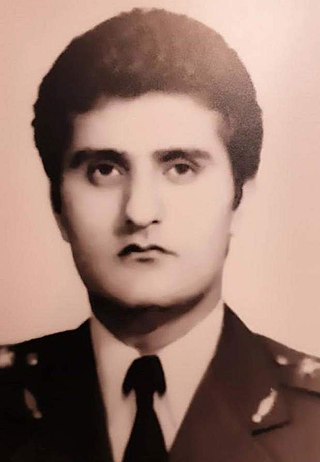Related Research Articles

The Islamic Republic of Iran Air Force (IRIAF); Persian: نیروی هوایی ارتش جمهوری اسلامی ایران, Nirvi-ye Hevayi-ye Artesh-e Jimhuri-ye Eslâmi-ye Iran) is the aviation branch of the Islamic Republic of Iran Army. The present air force came into being when the Imperial Iranian Air Force was renamed in 1979 following the Iranian Revolution. The IRIAF was heavily involved in the Iran–Iraq War, carrying out major operations like Operation Kaman 99, Operation Sultan 10, the H-3 airstrike, and the first attack on a nuclear reactor in history, Operation Scorch Sword. As a result of eight years of aerial combat in that conflict, the IRIAF has the second highest claimed number of fighter aces in the region, exceeded only by the Israeli Air Force; as many as seven IRIAF pilots claimed more than six kills, mostly achieved in the F-14 Tomcat. Veterans of the Iran–Iraq War would go on to form the core of the IRIAF command.

The HESA Saeqeh, alternatively spelt Sa'eqeh; Saegheh, or Saeqeh-80, is an Iranian built single-seat jet fighter, derived from the American Northrop F-5. A joint product of the Islamic Republic of Iran Air Force and the Iranian Ministry of Defence, it is the second generation of the Iranian Azarakhsh fighter. Saeqeh aircraft were tested successfully in Iran 20 September 2007.
Operation Alborz, more commonly known by the code-name Operation Kaman 99, was an operation launched by the Iranian Air Force in retaliation to Iraqi surprise aerial attacks on Iran the day before which marked the beginning of the 8-year-long Iran–Iraq War. Involving nearly 200 aircraft, it is considered the largest operation carried out by the IRIAF. The outcome was clearly successful, as the Iranians achieved air superiority for the first years of the conflict.

Jalil Zandi was a fighter pilot in the Islamic Republic of Iran Air Force (IRIAF) who served during all of the Iran–Iraq War. His combat record qualifies him as one of the most successful pilots of that conflict in air-to-air combat, as well as one of the best Iranian aces ever. It also made him the highest-scoring pilot in the history of the F-14 Tomcat.

Abbas Babaei was an Iranian pilot and brigadier-general in the Islamic Republic of Iran Air Force (IRIAF), during the Iran-Iraq War.

The H-3 airstrike was a surprise air attack by the Iranian Air Force during the Iran–Iraq War on 4 April 1981 against the airbases of the Iraqi Air Force at the H-3 Air Base in western Iraq. The Iranians destroyed at least 48 Iraqi aircraft on the ground with no losses of their own. Based on the results achieved, it is considered one of the most successful raids in the history of aerial warfare.
K. Sedghi was an Iranian F-14 Tomcat fighter pilot in the Islamic Republic of Iran Air Force during the Iran–Iraq War. Sedghi has been credited with 5 confirmed aerial victories against Iraqi aircraft during the war, a record that qualifies him as a flying ace.
Eagles is a 1984 Iranian film about an Iranian pilot, Yadollah Sharifirad, whose aircraft shot down by Iraqi Air Force during Iran–Iraq War. The story is about his escape back to Iran. This movie is considered the first major war movie in Iranian cinema. It is estimated that 18 percent of Iranian population watched the movie at the time.

Houshang Seddigh was an Iranian fighter pilot. He served as the commander of the Air Force from 1983 to 1986.

Baba Nazar is a book written by Hossein Beyzayi and edited by Mostafa Rahimi and Ahmad Dehqan. The book is the result of oral interviews with Mohammad Hassan Nazarenejad, during which the narrator recounts his stories about Iranian Revolution and Iran–Iraq War. Mohammad Hassan Nazarenejad known as Baba Nazar, the narrator of this book, was in the Iran–Iraq War for 140 months who died eight years after the war because of war injuries, in 1997.
Mohammad Doroudian is an Iranian writer, historian, researcher and theorist.

The several branches of the Armed Forces of the Islamic Republic of Iran are represented by flags. Within the Iranian military, various flags fly on various occasions, and on various ships, bases, camps, and military academies.

Assadollah Adeli is an Iranian retired fighter pilot on the Grumman F-14 Tomcat who served during the Iran–Iraq War. He was an elite pilot in the Iranian Air Force, and in 1977 he was one of the few pilots in the Imperial Iranian Air Force who were selected to fly the F-14. He flew the aircraft between 1980 and 1988, during the Iran-Iraq war.
Jamshid Afshar is an Iranian retired fighter pilot who flew with Grumman F-14 Tomcat during the Iran–Iraq War. He has been credited him with 5 or 6 confirmed aerial victories, a record that qualifies him as a flying ace.
Jalil Moslemi is an Iranian retired fighter pilot of Grumman F-14 Tomcat who served during the Iran–Iraq War.
The Foundation for the Preservation and Publication of Sacred Defense Works and Values is one of the institutions of the Islamic Republic of Iran with the aim of preserving the relics and disseminating the values of the Sacred Defense and promoting the culture of resistance, self-sacrifice, jihad and martyrdom. It was established by order of the Supreme Leader of Iran at the end of Iran-Iraq war in October 1990. This foundation is headed by Sardar Bahman Kargar and its parent department is General Staff of the Armed Forces of the Islamic Republic of Iran.

Hashem Al-e-Agha was an Iranian fighter pilot. Al-e-Agha is regarded as one of the most distinguished air force commanders during the Iran–Iraq War and gained a fearful reputation in Iraq as a skilled F-14 Tomcat pilot.
Mahmoud Zarrabi is a retired McDonnell Douglas F-4 Phantom II pilot of the Iranian Air Force who was one of the fighter pilots of the Air Force during the Iran-Iraq war.
References
- ↑ "رشادتهای خلبانان نیروی هوایی ارتش در دوران دفاع مقدس قابل بیان نیست". پایگاه اطلاع رسانی دیارمیرزا (in Persian). 2019-01-04. Retrieved 2022-04-05.
- ↑ Cooper, Tom; Bishop, Farzad (2004), Holmes, Tony; Hales-Dutton, Bruce (eds.), Iranian F-14 Tomcat Units in Combat, Osprey Combat Aircraft, vol. 49, Oxford: Osprey Publishing, ISBN 1-84176-787-5 .
- ↑ Behnegarsoft.com (2019-09-24). "نیروی هوایی بیش از سایر نیروهای ارتش در دوران دفاع مقدس حضور فعال داشت | ایبنا". خبرگزاری کتاب ايران (IBNA) (in Persian). Retrieved 2022-04-05.
- ↑ Tony Holmes & Bruce Hales (۲۰۰۴)، "THE REQUIREMENT"، IRANIAN F-14 TOMCAT UNITS IN COMBAT، London: Ospreypublishing، شابک ۱-۸۴۱۷۶-۷۸۷-۵.
- ↑ "وقتي "عباس" دستور پرواز داد؛ خاطره يك خلبان از عقاب تيزپرواز آسمان عشق". ایسنا (in Persian). 2012-04-19. Retrieved 2022-04-05.
- ↑ Razoux, Pierre (2015), The Iran-Iraq War, translated by Nicholas Elliott, Harvard University Press, ISBN 978-0-674-91571-8 .